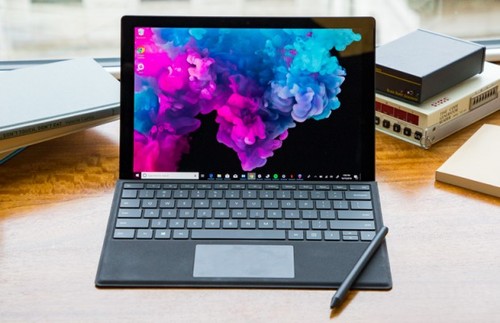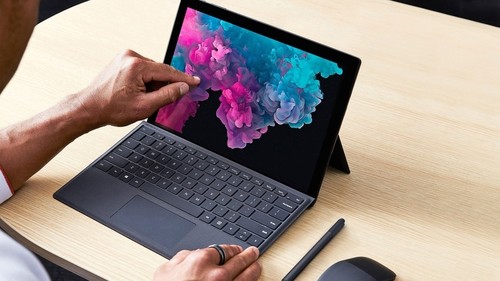Microsoft’s current Surface devices started as a pet project for their device chief, Panos Panay. Before he came into the picture, the Surface line was nothing more than a high-end POS system. But, with his guidance, Surface devices became the face of the modern Windows PC in all its forms.
They weren't the first to design a tablet/laptop hybrid. They weren’t even nowhere near the top PC manufacturers out there when they started with their hardware. But they were the first to make the concept at least fathomable to the average user. Their first foray into the scene was met with decent reception. That was all it took to get the ball rolling. That, it seems, was all that was required for Microsoft to go all-in on developing their hardware. From then on, Microsoft was no longer just a software company, it’s become a hardware manufacturer as well.
Eventually, the built-in hinge of the Surface Pro, the powerful detachable tablet form-factor of the Surface Book, and the overall design of the Surface Laptop have become industry hardware templates. They're copied by veteran computer makers such as Lenovo, Dell, and HP. More than anything, they’ve become a vision of what Windows can do.
Now, with its seventh-generation mere days away from being announced, fans eagerly await the Surface Pro 7. The rumours swirling around it might just shake up the tech world yet again. This includes ARM-based Surface 7, Thunderbolt 3 USB-C, and modernized bezel design
Rich Options for Processors
The Surface Pro 6 came in just two processor options – the i5 and i7. Both are from Intel’s 8th generation chipsets that introduced quad-core chips for laptops. The resulting outcome from those new chips improved battery life and increased processing capabilities at the same time. It’s a significant improvement from the Surface Pro 5 to the Surface Pro 6 at the time.
Surface Pro 7 should get a processor upgrade to Intel’s 10th generation processors. Intel revealed specs for these processing units earlier in the year. Based on their reveal, the trend for more powerful yet more efficient chips should continue with the Surface Pro 7. The only difference this generation is that they’re reportedly going to offer an i3 unit this year.
If these rumours are true, then we could be in for a price reduction for the base model. This could spell a huge boost in sales for down-market fans.
However, there's an even more exciting tidbit of news for people looking for an inexpensive way to own a Surface. People who don't need much processing power but requires the versatility of the Surface form-factor has another option. Some rumours state that an ARM-based Surface 7 is also in the works. These devices should be less expensive than the Pros. If this is true, you've got an even lower barrier to entry for Surface devices this year.
This confirms earlier rumours that state that Microsoft is in bed with Qualcomm for new hardware. The computer chip company is famous for producing Snapdragon-branded processing units. The Surface 7 should, therefore, be in line with the recently unveiled marketing push by Microsoft on Always-On PCs. While the chipsets aren’t as powerful as the Intel processors, they should be more than enough for regular tasks. Web browsing, document creation, and basic video editing should be a cinch for this device. It also adds the benefit of having 4G or maybe even 5G connectivity built into the device. All of these while also potentially doubling the current battery capacity.
In a way, the Surface 7 would probably be more like a tablet-first device like the iPad Pro versus the laptop-first experience of the Surface Pro. Overall, the expectation of a more than 10-hours of battery life on a single charge, the built-in LTE radio, and the portability of this new Windows machine looks to be the main selling points of the Surface 7.
USB-C, Finally
Since the Surface Pro 4, rumours have swirled about USB-C. It’s the inescapable future of computing. Even Apple, infamous for being slow to adopt new tech, has beaten Microsoft to the punch by using it as the iPad Pro’s primary power delivery system. The Redmond giant is adamant in keeping its proprietary Surface Connect.
Again, the USB-C rumours are getting fans hyped for the new device. Will people finally get what they want? Leaks say yes. But, as in the years before, it’s probably best to temper expectations to avoid disappointment like with past Surface Pros.
If there is some truth to the rumours, I expect the Surface to keep the Surface Connect. The USB-C would most likely be utilized mainly as a port for peripherals more than anything else. If you remember the Asus Transformer 3 Pro from way back 2016, you’d know how awesome it is to game on a tablet with an eGPU hooked up to it via Thunderbolt 3 port.
The Bezels are Going Away
One of the things that kept some people from going for the new Surface Pro 5 and 6 are the huge bezels. They're just no longer in vogue. Pundits believe that the bezels were merely kept because removing it would diminish the tablet experience. And they’re probably right. You need to be able to hold the device properly without accidentally triggering the touchscreen if you're using it in tablet mode.
The bezels, at least on the Surface Pro, looks like it’s on its way out. This should be a more workable upgrade this iteration. Microsoft looks like they’re moving away from their tablet dreams. While we still expect it to be a touchscreen device, Microsoft might finally throw in the towel on the tablet experience. The Surface Pros have always been outstanding laptops but middling, at best, as tablets.
Whether the Surface 7 is going to debut with the same design is still a coin toss. It would make sense if Microsoft sticks with the bezels on the device that’s more likely to be used as a tablet rather than a laptop.
They weren't the first to design a tablet/laptop hybrid. They weren’t even nowhere near the top PC manufacturers out there when they started with their hardware. But they were the first to make the concept at least fathomable to the average user. Their first foray into the scene was met with decent reception. That was all it took to get the ball rolling. That, it seems, was all that was required for Microsoft to go all-in on developing their hardware. From then on, Microsoft was no longer just a software company, it’s become a hardware manufacturer as well.
Eventually, the built-in hinge of the Surface Pro, the powerful detachable tablet form-factor of the Surface Book, and the overall design of the Surface Laptop have become industry hardware templates. They're copied by veteran computer makers such as Lenovo, Dell, and HP. More than anything, they’ve become a vision of what Windows can do.
Now, with its seventh-generation mere days away from being announced, fans eagerly await the Surface Pro 7. The rumours swirling around it might just shake up the tech world yet again. This includes ARM-based Surface 7, Thunderbolt 3 USB-C, and modernized bezel design
Rich Options for Processors
The Surface Pro 6 came in just two processor options – the i5 and i7. Both are from Intel’s 8th generation chipsets that introduced quad-core chips for laptops. The resulting outcome from those new chips improved battery life and increased processing capabilities at the same time. It’s a significant improvement from the Surface Pro 5 to the Surface Pro 6 at the time.
Surface Pro 7 should get a processor upgrade to Intel’s 10th generation processors. Intel revealed specs for these processing units earlier in the year. Based on their reveal, the trend for more powerful yet more efficient chips should continue with the Surface Pro 7. The only difference this generation is that they’re reportedly going to offer an i3 unit this year.
If these rumours are true, then we could be in for a price reduction for the base model. This could spell a huge boost in sales for down-market fans.
However, there's an even more exciting tidbit of news for people looking for an inexpensive way to own a Surface. People who don't need much processing power but requires the versatility of the Surface form-factor has another option. Some rumours state that an ARM-based Surface 7 is also in the works. These devices should be less expensive than the Pros. If this is true, you've got an even lower barrier to entry for Surface devices this year.
This confirms earlier rumours that state that Microsoft is in bed with Qualcomm for new hardware. The computer chip company is famous for producing Snapdragon-branded processing units. The Surface 7 should, therefore, be in line with the recently unveiled marketing push by Microsoft on Always-On PCs. While the chipsets aren’t as powerful as the Intel processors, they should be more than enough for regular tasks. Web browsing, document creation, and basic video editing should be a cinch for this device. It also adds the benefit of having 4G or maybe even 5G connectivity built into the device. All of these while also potentially doubling the current battery capacity.
In a way, the Surface 7 would probably be more like a tablet-first device like the iPad Pro versus the laptop-first experience of the Surface Pro. Overall, the expectation of a more than 10-hours of battery life on a single charge, the built-in LTE radio, and the portability of this new Windows machine looks to be the main selling points of the Surface 7.
USB-C, Finally
Since the Surface Pro 4, rumours have swirled about USB-C. It’s the inescapable future of computing. Even Apple, infamous for being slow to adopt new tech, has beaten Microsoft to the punch by using it as the iPad Pro’s primary power delivery system. The Redmond giant is adamant in keeping its proprietary Surface Connect.
Again, the USB-C rumours are getting fans hyped for the new device. Will people finally get what they want? Leaks say yes. But, as in the years before, it’s probably best to temper expectations to avoid disappointment like with past Surface Pros.
If there is some truth to the rumours, I expect the Surface to keep the Surface Connect. The USB-C would most likely be utilized mainly as a port for peripherals more than anything else. If you remember the Asus Transformer 3 Pro from way back 2016, you’d know how awesome it is to game on a tablet with an eGPU hooked up to it via Thunderbolt 3 port.
The Bezels are Going Away
One of the things that kept some people from going for the new Surface Pro 5 and 6 are the huge bezels. They're just no longer in vogue. Pundits believe that the bezels were merely kept because removing it would diminish the tablet experience. And they’re probably right. You need to be able to hold the device properly without accidentally triggering the touchscreen if you're using it in tablet mode.
The bezels, at least on the Surface Pro, looks like it’s on its way out. This should be a more workable upgrade this iteration. Microsoft looks like they’re moving away from their tablet dreams. While we still expect it to be a touchscreen device, Microsoft might finally throw in the towel on the tablet experience. The Surface Pros have always been outstanding laptops but middling, at best, as tablets.
Whether the Surface 7 is going to debut with the same design is still a coin toss. It would make sense if Microsoft sticks with the bezels on the device that’s more likely to be used as a tablet rather than a laptop.


